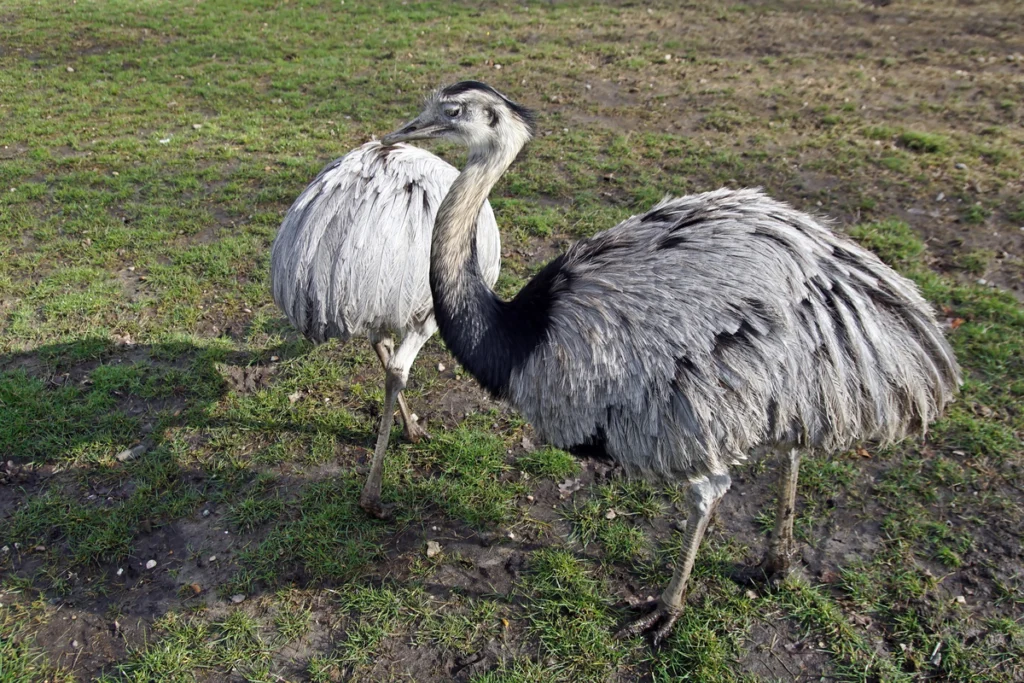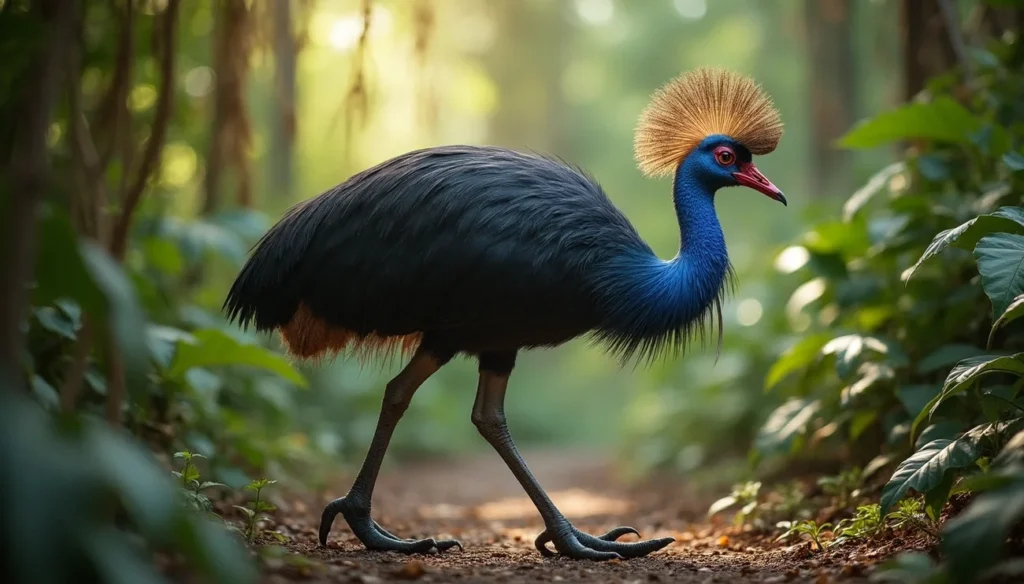The cassowary earned its reputation as “the world’s most dangerous bird” for good reason. Armed with a 12 cm dagger-like claw on each foot, this flightless giant can deliver lethal wounds when threatened. In 2019, a cassowary attack resulted in the death of a 75-year-old man in Florida, demonstrating the legitimate danger these birds pose. Despite their intimidating reputation, cassowaries are typically shy creatures that prefer avoiding human contact.
Standing up to 190 cm tall and weighing as much as 85 kg, the southern cassowary is the second heaviest bird worldwide after the ostrich. These remarkable birds can sprint at speeds of up to 50 km/h through dense forest underbrush, making encounters particularly hazardous.
Although cassowary attacks on humans remain rare, studies show that 75% of recorded incidents involved birds that had been previously fed by people, highlighting the risks of habituating these powerful animals. Indeed, the cassowary’s impressive physical attributes, including its distinctive casque and low-frequency vocalizations that can be felt as chest vibrations contribute to its status as one of nature’s most formidable creatures.
What is a cassowary?

Classified as ratites alongside ostriches and emus, cassowaries belong to the genus Casuarius – flightless birds characterized by their inability to fly due to flat breastbones without keels. Their appearance often prompts comparisons to prehistoric creatures, resembling a cross between a turkey and a dinosaur.
Species overview: southern, northern, and dwarf cassowary
Three distinct cassowary species inhabit our planet today:
- Southern cassowary (Casuarius casuarius): The most well-known species, found in northern Queensland and New Guinea. This bird features two prominent red wattles hanging from its neck and is sometimes called the double-wattled cassowary.
- Northern cassowary (Casuarius unappendiculatus): Discovered by scientists in 1860, this species typically has a single wattle (occasionally two) that can be yellow, red, or blue in color.
- Dwarf cassowary (Casuarius bennetti): The smallest of the three species, lacking wattles but displaying a round purple spot where wattles would be and bright pink spots on its cheeks.
Where they live: New Guinea, Australia, and nearby islands
Cassowaries primarily inhabit tropical forests across northern Australia, New Guinea, and surrounding islands. The southern cassowary lives in coastal lowland rainforests in northern Queensland, Australia, and is also found throughout New Guinea. Moreover, the north cassowary dwells exclusively along rivers and coastal swampy lowlands of New Guinea.
Meanwhile, the dwarf cassowary prefers higher elevations of New Guinea, leaving lowland rainforests to its larger relatives.
Cassowary size and appearance
As the third-largest bird globally (after ostriches and emus), the southern cassowary stands impressively tall. Female southern cassowaries can reach up to 2 meters in height and weigh as much as 76 kg, while males typically weigh around 55 kg. Furthermore, these birds feature a striking appearance with glossy black feathers that differ significantly from other birds – they have quills that split in two and lack the barbules that typically hold birds’ feathers together.
Notably, every cassowary possesses a distinctive hollow, pointed casque atop its head made of keratin – the same material as human fingernails. Recent studies suggest this structure serves as a thermal window for releasing body heat. Adult birds display vibrant blue necks with red wattles (in southern and northern species), creating a dramatic contrast against their black plumage.
The anatomy of danger: what makes cassowaries deadly
Behind the cassowary’s fearsome reputation lies a suite of remarkable anatomical adaptations that make it a truly formidable creature. Unlike most birds that rely on flight to escape predators, cassowaries have evolved specialized features for survival and defence.
The cassowary claw: a natural weapon
Each cassowary foot has three toes, with the inner toe bearing a dagger-like claw that can reach a staggering 12 cm (5 inches) in length. This formidable weapon is connected to muscular legs capable of delivering powerful kicks.
If threatened, a laws, potentially inflicting lethal wounds to internal organs. Indeed, these weapons are so effective that cassowaries can reportedly slice open predators such as crocodiles, pythons, and dingos.
Cassowary’s speed and jumping ability
Equally impressive is the cassowary’s mobility. These birds can sprint at speeds up to 50 km/h (30 mph) through dense forest. Beyond this, they possess remarkable leaping ability, jumping up to 1.5 meters (5 feet) from a standstill. Some sources even report jumping heights of up to 2 meters or 7 feet. This combination of speed and agility makes escape nearly impossible if a cassowary decides to pursue.
The casque: more than just a helmet
The distinctive casque atop the cassowary’s head serves multiple functions. Contrary to popular belief, it’s not primarily for protection when running through forests. Instead, recent studies confirm it works as a thermal window for regulating body temperature.
In cool weather, blood vessels constrict to retain heat, whereas in hot conditions, these vessels dilate to release excess heat.
Cassowary sound: low-frequency booms
Cassowaries produce intense vocalizations – the lowest-frequency bird call known. These booms can reach as low as 32 hertz, just above human hearing range. Strikingly, these sounds are felt as much as heard, creating vibrations in a listener’s chest cavity. The cassowary produces these vibrating rumbles from deep within, amplifying them with its casque.
Cassowary bird attack cases
Data from 221 documented cassowary attacks reveals that 150 were against humans. Notably, 75% of these birds were previously fed by humans. During confrontations, cassowaries charged or chased victims in 71% of incidents and kicked in 15%. Most attacks (73%) occurred when cassowaries were expecting food from humans.
Though rare, fatal attacks have occurred, most notably in 1926 when a 16-year-old boy received a fatal neck wound, and more recently in 2019 when a 75-year-old Florida man was killed.
Behaviour and survival in the wild
In the depths of rainforests across Australia and New Guinea, cassowaries lead remarkably structured lives as solitary creatures that meet primarily for breeding.
Solitary lifestyle and territorial nature
Adult cassowaries maintain separate territories throughout most of the year. Males fiercely defend their territory of approximately 2.8 square miles (7 square kilometres), generally avoiding other cassowaries except during breeding season. Females, however, possess larger territories that may overlap with several males’ smaller ranges.
Home range studies reveal that females have territories 3 to 6 times larger than those of males, with average ranges spanning from 0.52 to 2.35 square kilometres. When two males accidentally meet, they engage in intimidation displays, stretching tall, fluffing feathers, and emitting rumbling sounds until one retreats.
Cassowary diet and seed dispersal
Essentially functioning as “rainforest gardeners,” cassowaries consume fruits from over 238 plant species. Their short digestive tract allows seeds to pass through unharmed, distributing them throughout the forest in nutrient-rich droppings.
This unique capability makes cassowaries a keystone species in their ecosystems. They’re the only animals capable of distributing seeds from more than 70 large-fruited rainforest trees. Research confirms that seeds from certain Australian rainforest trees have germination rates of 92% after passing through a cassowary’s digestive system, compared to just 4% for seeds that fall naturally.
Breeding habits and cassowary eggs
The breeding season typically runs from June through October, when fruit is most abundant. After courtship rituals involving distinctive movements and low-frequency “boo-boo-boo” calls, females practice sequential polyandry, mating with multiple males in succession.
Each female may lay clutches of 3-5 large, bright green eggs in separate males’ nests. Males create simple nests on the forest floor lined with leaves and vegetation.
How cassowaries raise their young
Uniquely among birds, male cassowaries handle all parental duties. After the 50-day incubation period, males protect the chicks, teach feeding behaviours, and lead them to food sources for 9-18 months.
Fathers clack their bills next to food sources to encourage chicks to feed and even capture insects as nutritional supplements for their young. This intense paternal investment ends when fathers eventually chase their nearly full-grown offspring away to establish their territories.
Human encounters and conservation efforts
Despite their imposing appearance, studies reveal that cassowary attacks occur primarily due to human behaviours that alter these birds’ natural habits. Understanding this relationship has become crucial for conservation efforts.
Why do cassowary attacks happen
Analysis of 221 documented cassowary attacks shows that 150 were against humans. Specifically, 75% of these attacks were caused by humans feeding the birds. Only 22% involved cassowaries defending themselves or their eggs.
During confrontations, cassowaries charged or chased victims in 71% of incidents and kicked in only 15%. Contrary to common belief, jogging does not provoke attacks.
Urban cassowaries and human feeding
The consequences of feeding cassowaries extend beyond immediate danger. In urbanized areas of Queensland and Port Moresby, cassowaries have adapted to less forested environments. These “urbanized” cassowaries consume approximately 30% of their diet from exotic plants.
Feeding has deadly consequences. Autopsies on cassowaries killed by vehicles frequently reveal chopped bananas and grapes in their digestive tracts. Feeding cassowaries is illegal under Queensland law, with maximum penalties of USD 5,222.
Wildlife experts emphasize that feeding makes cassowaries associate vehicles with food sources, subsequently leading to road deaths. As Dr. Lauridsen notes, “It is 100 percent the reason those birds have died”.
Conservation status of the southern cassowary
The southern cassowary faces significant threats to its survival. Listed as “Endangered” under Australia’s Environment Protection and Biodiversity Conservation Act and Queensland’s Nature Conservation Act, population estimates suggest approximately 4,000 individuals remain in Australia. The Wet Tropics population continues to decline despite slower habitat loss.
Efforts to protect cassowary habitat
Conservation initiatives include several coordinated approaches. The Cassowary Recovery Team implements the national recovery plan to “protect cassowaries, habitats and corridors from threats through better planning, monitoring and community involvement”. Achievements include habitat mapping, property acquisition in key areas, corridor completion, traffic calming measures, and post-cyclone feeding protocols.
Rehabilitation centres like Garner’s Beach Cassowary Rehabilitation Facility provide care for injured and orphaned birds. Educational campaigns, such as “Be Cass-O-Wary” and “A fed bird is a dead bird,” aim to reduce harmful human interactions. Consequently, these collaborative efforts between government agencies, conservation groups, and local communities offer hope for the future of this remarkable species.
Conclusion
The cassowary stands as a remarkable testament to nature’s evolutionary ingenuity. Throughout this exploration, we’ve uncovered why these prehistoric-looking birds earn their title as nature’s most dangerous avians. Their dagger-like claws, impressive speed, and powerful legs certainly make them formidable creatures capable of inflicting serious harm when threatened.
Despite their fearsome reputation, cassowaries rarely seek confrontation with humans. Instead, most documented attacks stem directly from human behaviour, particularly feeding these wild animals. This practice disrupts their natural behaviours and creates dangerous dependencies, ultimately leading to their demise through vehicle strikes and habitat loss.
Ecologically speaking, cassowaries fulfil an irreplaceable role in rainforest ecosystems. Their unique ability to disperse large seeds makes them true “rainforest gardeners,” essential for maintaining biodiversity across their natural ranges in Australia and New Guinea. Without cassowaries, many plant species would lose their primary method of reproduction and dispersal.
Conservation efforts face significant challenges as southern cassowary populations continue declining. Habitat fragmentation, vehicle strikes, and human encroachment threaten their long-term survival. Thankfully, dedicated conservation programs combine habitat protection, rehabilitation facilities, and public education campaigns to address these threats.
The cassowary thus represents both a warning and an opportunity. These ancient birds remind us how human activities directly impact wildlife survival. Their continued existence depends largely on our willingness to respect their space, protect their habitats, and acknowledge their importance to rainforest ecosystems.
The fate of these magnificent birds, living dinosaur descendants, rests squarely in human hands.

